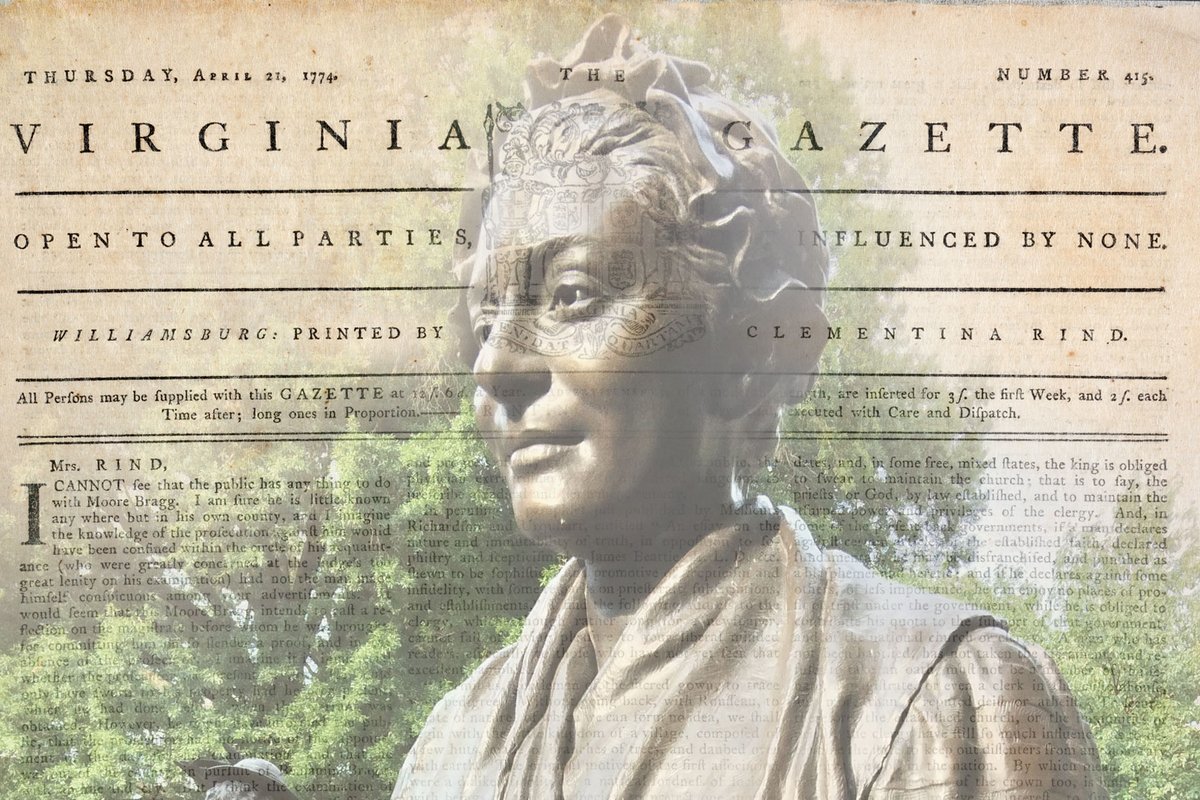
The Widow Who Printed the American Revolution
A Bold Type: Clementina Rind’s Revolutionary Press
Not long after her husband’s funeral, Clementina Rind sat down at his desk, now hers, to write. “Being now unhappily forced to enter upon Business on my own Account,” she wrote, she was obliged to ask the subscribers of her newspaper the Virginia Gazette to “be punctual” in sending payments.
Her grief is visible on the page. “May that All Ruling Power,” she wrote, “whose chastening Hand has snatched from my dear Infants and myself our whole Dependence, make me equal to the Task!” She ended with a humble plea to the House of Burgesses to renew her husband’s printing contract, and “bestow Happiness and Plenty on my orphan Family.”
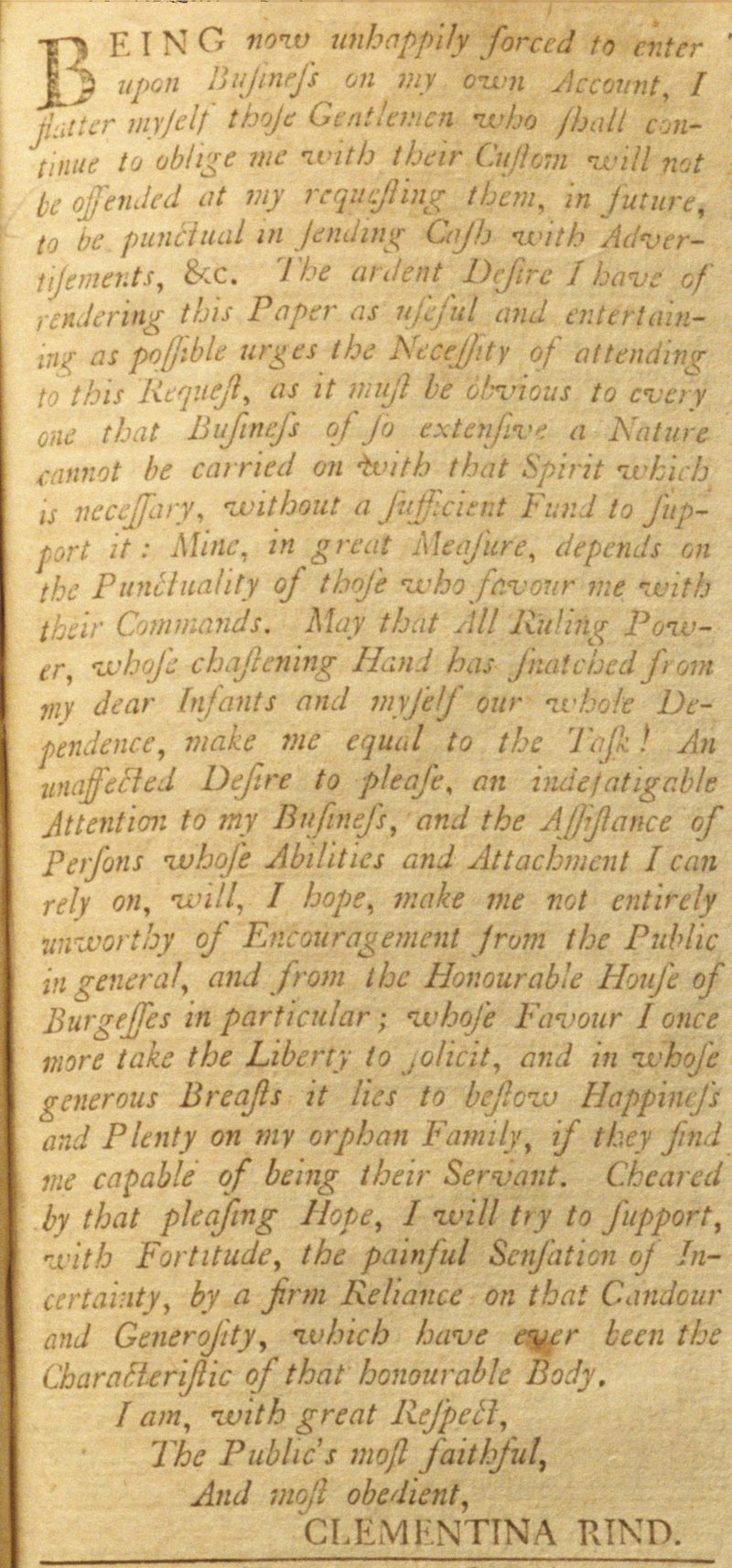
Virginia Gazette (Rind), Sept. 2, 1773, page 3.
She wrote that she felt a “painful Sensation of Incertainty.” Her husband William Rind had died, leaving behind a mountain of debt. How would she maintain the business, while also caring for her five children? How would she satisfy her husband’s creditors? During the thirteen months following William’s death, she deftly navigated these challenging circumstances. She died the next year, but not before serving as Virginia’s public printer and lending her voice to the cause of the American Revolution.
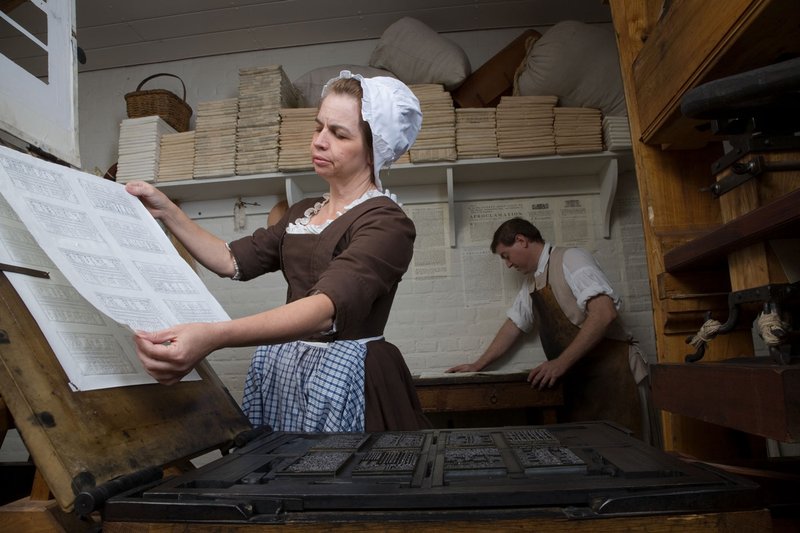
Archival image of character interpreter Abigail Schumann portraying Clementina Rind at Colonial Williamsburg’s print shop.
“on my own Account”: A Widow’s Business
We don’t know much about Clementina Rind’s life before she took over her husband’s printing business. Born around 1740, she was probably married to William between 1762 and 1765 in Annapolis, Maryland.1 Her name seldom appears in the historical record before William died on August 19, 1773.
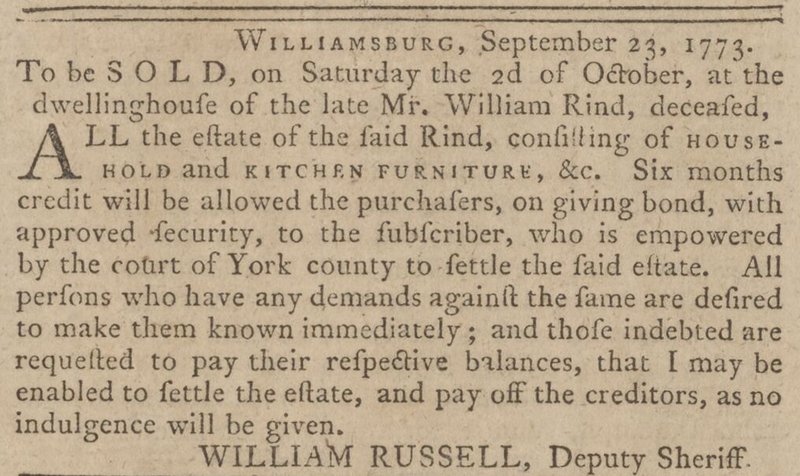
Virginia Gazette (Rind), Sept. 23, 1773, page 3.
As in other trades, printers’ wives usually contributed to the family business. Clementina could have hardly avoided the print shop, since it was part of her home. She became very familiar with the trade. After her husband’s death, she maintained publication of the Gazette without missing an issue.
To pay William’s debts, a sheriff auctioned off most of the family’s possessions. Clementina had to part with her home and many of her possessions. However, on six months’ credit, she managed to purchase her husband’s most valuable possession: his printing press.2 If she could keep the public printing contract that her husband had earned, she could make enough money to repay the debt. It was a gamble.
But for the first time in her life, these risks were hers to take. In eighteenth-century America, the law of coverture denied most women the legal right to own a business or take loans. Fathers were expected to manage financial affairs for their daughters, and husbands for their wives. The only women who could conduct their own business and legal affairs were widows. Rind took advantage of the opportunities presented by widowhood. Only a few days into widowhood, she declared her intention to set out “on my own Account.”
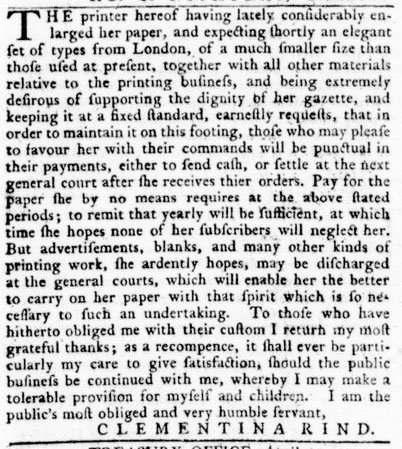
Virginia Gazette (Rind), April 14, 1774, page 3.
Over the next year, Rind secured a loan from several gentlemen in Williamsburg, including the mayor. She seems to have used part of this loan to order a new set of type from London, indicating that she hoped to expand her business.3
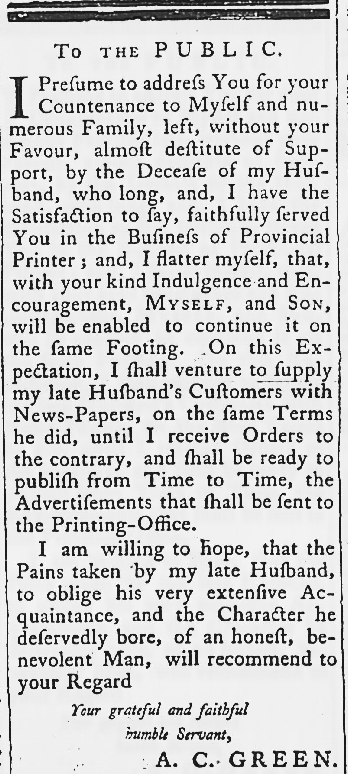
Announcement of Jonas Green’s death in Maryland Gazette, April 16, 1767.
Rind was one among dozens of widows who ran print shops in eighteenth-century North America.4 One of these printers was Anne Green, who took over her husband Jonas’s business after his death in 1767. William Rind and Jonas Green had been business partners in Annapolis, before the Rinds moved to Williamsburg. The families would have known each other well. When William died, then, Clementina would have already known another woman running a printing business. Perhaps she was an inspiration for Clementina to press on.5
Revolutionary Printer
Rind’s paper documented rising tensions during a pivotal moment in the American Revolution. On May 19, 1774, as news arrived that Parliament would close Boston harbor as punishment for the Boston Tea Party, Rind wrote an unusually political note in the Gazette attacking Britain and defending the “just privileges of America.”6
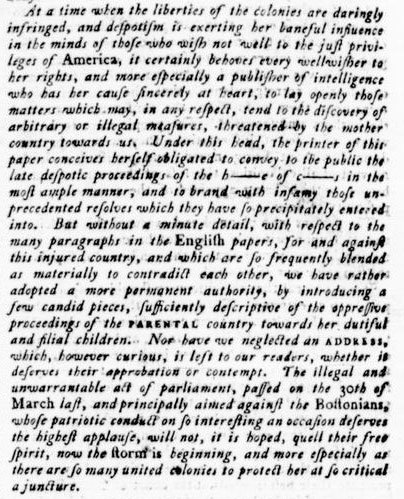
Virginia Gazette (Rind), May 19, 1774, page 2.
A few days later, the House of Burgesses voted for her to continue as the public printer for Virginia. It’s a good thing they didn’t wait. Moments before taking up the matter of the public printer, the House of Burgesses voted to set aside a day of fasting, humiliation, and prayer in recognition of the closing of Boston harbor. Two days later, Governor Dunmore dissolved the House of Burgesses in response.7
During this moment of crisis, Rind was responsible for printing one of the most radical texts that Virginia had yet seen. In July 1774, Thomas Jefferson set out for Williamsburg to join an extralegal meeting of delegates at what would become known as the First Virginia Convention. But while traveling, an attack of dysentery sent Jefferson home. Having prepared a set of resolutions for the convention, he sent copies of them ahead to Peyton Randolph and Patrick Henry. As Jefferson later recounted in his Autobiography, Henry didn’t do anything with his copy, either because he disapproved of their sentiments or because “he was too lazy to read it (for he was the laziest man in reading I ever knew).”8 But Randolph shared the resolutions with other delegates. While some appreciated them, others felt that they went too far.
As a result, the more radical delegates took Jefferson’s drafted resolutions to Clementina Rind. On August 8, shortly after the convention closed, Rind published the resolutions as a pamphlet titled A Summary View of the Rights of British America. It rejected Parliament’s authority and insisted that the King was their only legitimate ruler in Britain. Though it was published anonymously, Jefferson believed his authorship of it caused Parliament to consider punishing him.9 If Jefferson was taking a risk by circulating this revolutionary text, Rind took an equal risk in publishing it.
Go Deeper
Read Jefferson’s Summary View, published by Clementina Rind, at the Library of Congress website.
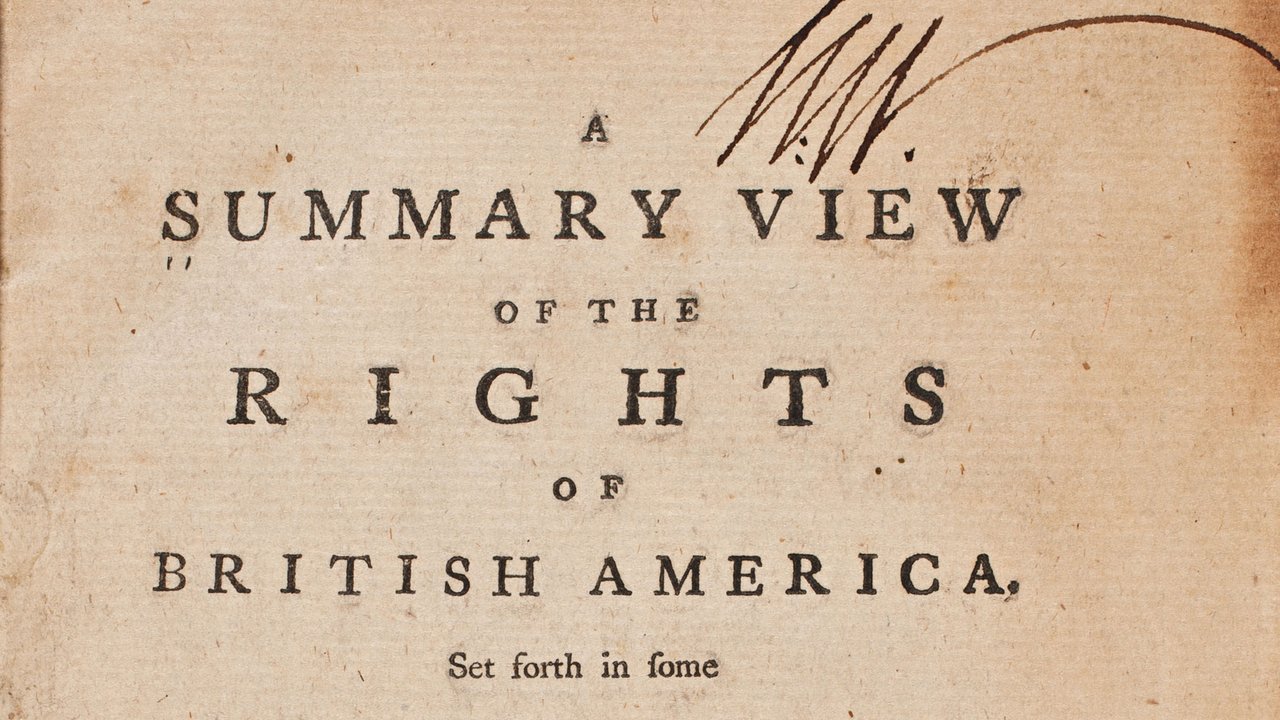
Legacy
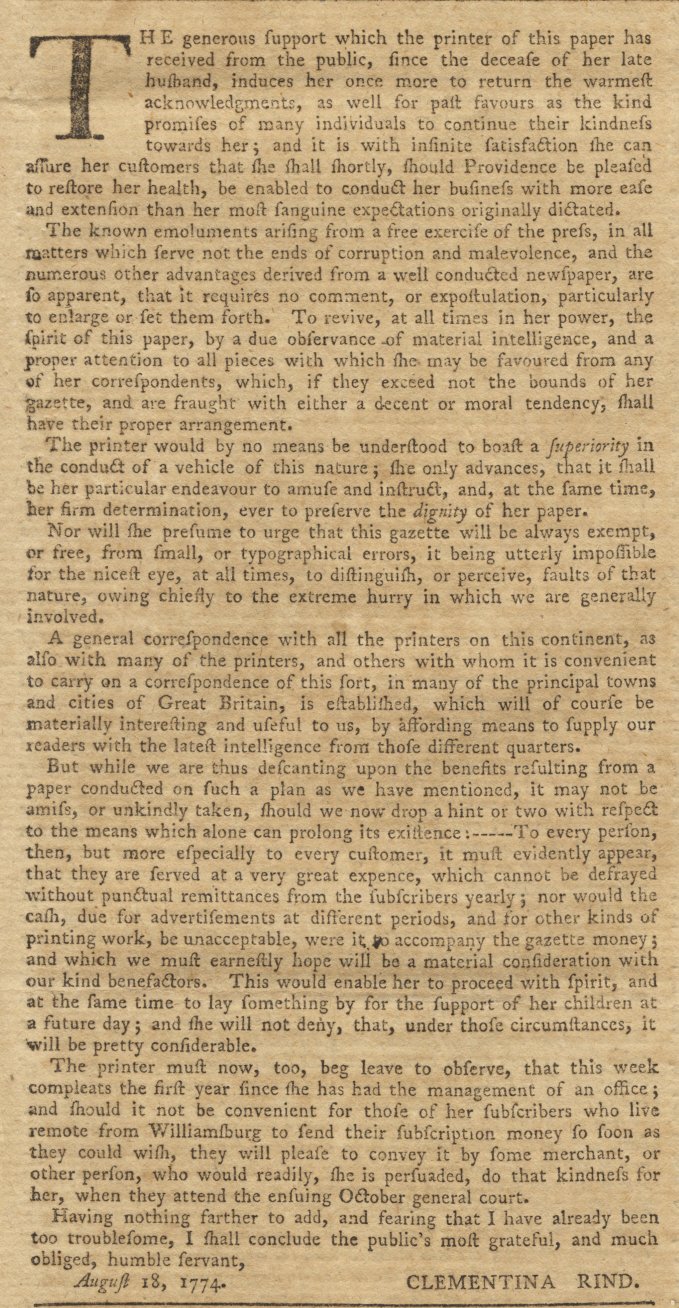
After she had printed the Gazette for a full year, Rind published a letter to subscribers thanking them and (as always) asking them to pay what they owed her. Virginia Gazette, Aug. 25, 1774, page one.
Clementina Rind was only in her thirties when she died on September 25, 1774. The other Virginia Gazette published in town by John Dixon and Alexander Purdie announced her death and concluded, “She was a Lady of singular Merit, and universally esteemed.”10 Rind’s own Gazette carried two poems memorializing her. The first of these praised her “manly sense, and fortitude of mind” combined with the “softer graces of her sex.” Both praised Rind’s intelligence and her skill as a writer.11
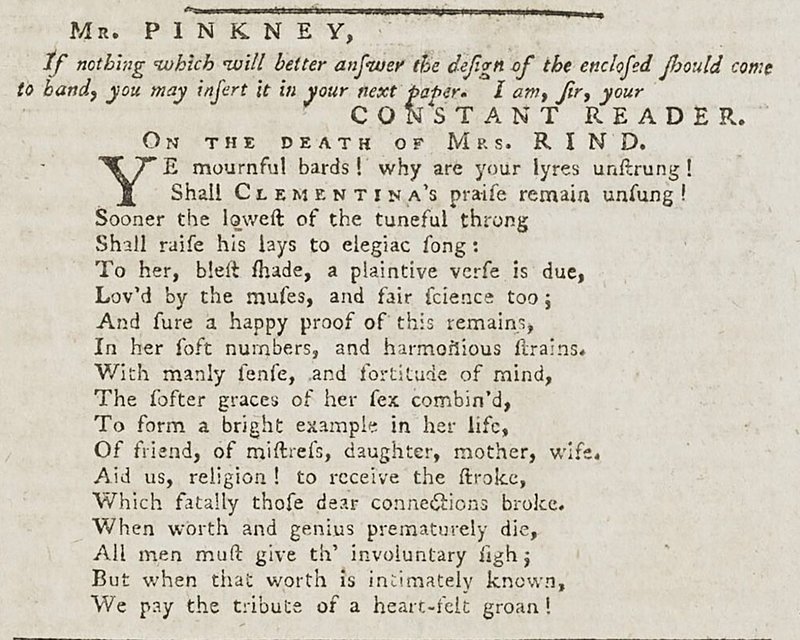
Virginia Gazette (Pinkney), Oct. 6, 1774, page 3.
During her career as publisher of the Virginia Gazette, Clementina Rind was one of the most visible and influential women in the colony. While her success was short-lived, it was not an accident. She was a skillful editor and a shrewd businessperson. When she died, her business and her children passed to a relative named John Pinkney, who worked in the print shop. However, Pinkney lost the government printing contract that the Rinds had maintained. Their Gazette ceased publication in 1776.12
Sources
Cover image: Clementina Rind statue at the Virginia Women’s Monument. Courtesy of Wikimedia Commons and Virginia Gazette (Rind), April 21, 1774.
- Martha J. King, “Clementina Rind: Widowed Printer of Williamsburg,” in Virginia Women: Their Lives and Times, ed. Cynthia Kierner and Sandra Gioia Treadway, vol. 1 (Athens: University of Georgia Press, 2015), 74, 81–82.
- King, “Clementina Rind,” 80.
- Virginia Gazette (Rind), April 14, 1774, p. 3.
- Leona M. Hudak, Early American women printers and publishers, 1639–1820 (Metuchen, N.J.: Scarecrow Press, 1978).
- King, “Clementina Rind,” 81.
- Virginia Gazette (Rind), May 19, 1774, p. 2.
- John Pendleton Kennedy, ed., Journals of the House of burgesses of Virginia 1773-1776 (Richmond: s.n., 1905), 124–25.
- Autobiography of Thomas Jefferson: 1745–1790, Together with A Summary of the Chief Events in Jefferson’s Life (New York: G. P. Putnam’s Sons, 1914), 15. Available online through the Library of Congress.
- Autobiography of Thomas Jefferson, 15.
- Virginia Gazette (Purdie and Dixon), Sept. 29, 1774, p. 4.
- See Virginia Gazette (Pinkney), Oct. 6, 1774; ibid., Oct. 20, 1774.
- Karen A. Weyler, Empowering Words: Outsiders and Authorship in Early America (Athens: University of Georgia Press, 2013), 167, 201.
